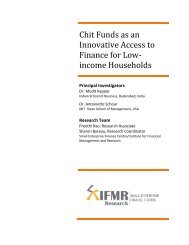Government of India Volume I: Analysis and Recommendations
Government of India Volume I: Analysis and Recommendations
Government of India Volume I: Analysis and Recommendations
Create successful ePaper yourself
Turn your PDF publications into a flip-book with our unique Google optimized e-Paper software.
ANNEXES<br />
16. Consumer protection regulation must be proportional to the risk held by the consumer,<br />
<strong>and</strong> the extent to which the consumer is responsible for taking decisions<br />
about the plan on issues such as investment.<br />
17. All individuals dealing with retirement financing must be registered with the regulator,<br />
who must stipulate significant training requirements on the individuals involved<br />
in the process <strong>of</strong> helping the consumers decide about retirement financing.<br />
18. The structure <strong>of</strong> various types <strong>of</strong> charges on retirement financing schemes should<br />
be regulated by the regulator.<br />
19. The regulator must be given the powers to ensure inter-operability, portability <strong>and</strong><br />
exit options in retirement financing plans.<br />
20. The regulator must have the power to m<strong>and</strong>ate suitability analysis <strong>and</strong> advice to<br />
be given by the provider to the consumer regarding the asset allocation decision.<br />
The regulator must also have the power to recommend modifications to schemes<br />
<strong>and</strong> processes to ensure that consumers are given suitable solutions.<br />
Failure <strong>of</strong> retirement finance funds<br />
21. The law should provide for an efficient resolution mechanism for funds <strong>of</strong>fering defined<br />
benefit retirement financing plans. This should be modelled on the resolution<br />
process for banking <strong>and</strong> insurance, but with more time for the funds to improve<br />
their financial position. There should be an agency responsible for the resolution<br />
function.<br />
22. There should be a process to move the consumers’ funds from one defined contribution<br />
fund to another smoothly, if the retirement finance entity sponsoring the<br />
defined contribution fund goes bankrupt.<br />
23. The agency responsible for resolution should have access to comprehensive information<br />
about retirement finance entities <strong>and</strong> funds. The agency should have access<br />
to auditors’ reports <strong>and</strong> the powers to ask for information on any fund <strong>and</strong><br />
conduct on-site investigation <strong>of</strong> a fund.<br />
24. The resolution process should start with a quantitative trigger.<br />
25. The resolution process should start with giving the fund a notice to improve its financial<br />
position. If the fund fails to do so, the process should focus on transfer <strong>of</strong><br />
the assets to another fund, or under the management <strong>of</strong> another fund. Liquidation<br />
<strong>of</strong> fund should be the last option in the resolution process. When resolution<br />
process starts, the fund should be prevented from collecting contributions<br />
26. Establishing a retirement finance protection fund, which would guarantee payouts<br />
from all defined benefit schemes, may be considered. The fund could also provide<br />
some guarantees to defined contribution schemes, to help them hedge certain investment<br />
risks.<br />
27. If the retirement finance protection fund is established, it should charge risk-based<br />
levy from the participating funds; participation should be m<strong>and</strong>atory for funds <strong>of</strong>fering<br />
defined benefit plans; <strong>and</strong> the fund could be managed by the agency that is<br />
responsible for resolution <strong>of</strong> failing funds.<br />
Special topics<br />
28. Only insurance companies that have proven capability in <strong>of</strong>fering life insurance<br />
should be allowed to do the business <strong>of</strong> issuing annuities.<br />
29. Compared to pension funds, for insurance firms issuing annuities, there should be<br />
greater flexibility given to the regulator in law to stipulate restrictions on investment<br />
choices. This should be in line with the regulations <strong>of</strong> life insurance companies.<br />
30. The regulators should work to ensure that consumers take the optimal annuitisation<br />
decision, by m<strong>and</strong>ating partial annuitisation <strong>and</strong> providing active support to<br />
consumers to take the right decision.<br />
172 FINANCIAL SECTOR LEGISLATIVE REFORMS COMMISSION



